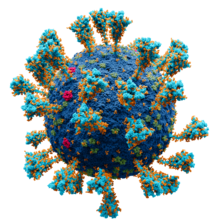
La medicina es la ciencia y la práctica de cuidar a los pacientes, gestionar el diagnóstico , el pronóstico , la prevención , el tratamiento , la paliación de sus lesiones o enfermedades y promover su salud . La medicina abarca una variedad deprácticas de atención médica desarrolladas para mantener y restaurar la salud mediante la prevención y el tratamiento de enfermedades . La medicina contemporánea aplica las ciencias biomédicas , la investigación biomédica , la genética y la tecnología médica para diagnosticar , tratar y prevenir lesiones y enfermedades, generalmente a través de productos farmacéuticos o cirugía , pero también a través de terapias tan diversas como la psicoterapia , férulas externas y tracción , dispositivos médicos , productos biológicos y radiación ionizante , entre otros.
La medicina se practica desde tiempos prehistóricos y durante la mayor parte de este tiempo era un arte (un área de creatividad y habilidad) que frecuentemente tenía conexiones con las creencias religiosas y filosóficas de la cultura local. Por ejemplo, un curandero aplicaba hierbas y rezaba oraciones para sanar, o un filósofo y médico antiguo aplicaba sangrías según las teorías del humorismo . En los últimos siglos, desde el advenimiento de la ciencia moderna , la mayor parte de la medicina se ha convertido en una combinación de arte y ciencia (tanto básica como aplicada , bajo el paraguas de la ciencia médica ). Por ejemplo, mientras que la técnica de sutura para suturas es un arte que se aprende a través de la práctica, el conocimiento de lo que sucede a nivel celular y molecular en los tejidos que se suturan surge a través de la ciencia.
Las formas precientíficas de medicina, hoy conocidas como medicina tradicional o medicina popular , siguen utilizándose habitualmente en ausencia de la medicina científica y, por ello, se las denomina medicina alternativa . Los tratamientos alternativos que no forman parte de la medicina científica y que tienen problemas éticos, de seguridad y de eficacia se denominan curanderismo . ( Artículo completo... )



Participe uniéndose a WikiProject Medicine . Hablamos sobre colaboraciones y todo tipo de cuestiones en nuestra página de discusión .





Los siguientes proyectos hermanos de la Fundación Wikimedia proporcionan más información sobre este tema: